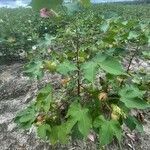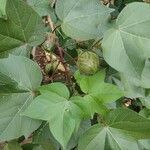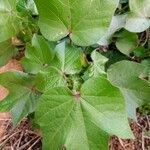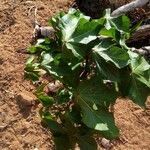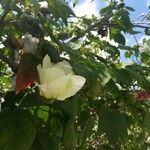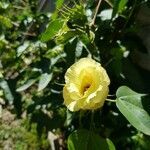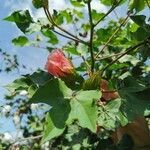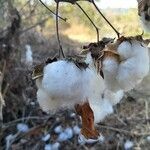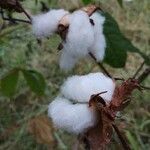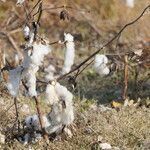Plants 1–2 m, usually widely branching. Stems terete, stellate-hairy. Leaves: stipules subulate to falcate, 5–15(–20) mm; petiole terete, 1/2 to as long as blade; blade shallowly 3–5-lobed, lobes broadly ovate, 4–10 cm, membranous, base cordate, apex acute to acuminate, surfaces glabrous or hairy. Inflorescences: flowers usually sympodial. Pedicels 2–4 cm, with 3-merous involucellar nectaries; involucellar bractlets persistent, foliaceous (enclosing bud), broadly cordate-ovate, 2–4.5 cm, margins laciniate. Flowers: calyx 5–6 mm (excluding teeth, if present), apex truncate or 5-toothed; petals cream, with or without red spot, 2–5 cm; staminal column 15 mm, glabrous; style somewhat exceeding androecium; stigmas 3–5. Capsules 3–5-locular, broadly ovoid or subglobose, 2–4 cm, smooth, glabrous. Seeds 8–10 mm, comose, hairs (cotton) usually white. 2n = 52.
An annual herb. It grows 0.6-1.5 cm high. The leaf blade has 3 lobes. The leaf blade is 5-12 cm across. The lobes are broad and oval. The lobes are less than half the leaf length. The flowers occur singly in the axils of leaves. The flowers are white or yellow becoming red or purple. They are 2.5-3 cm across. The fruit is a capsule 3.5-5 cm across. It has 3-4 cells. The seeds are oval and white and woolly. The seeds are covered with very long seed hairs called cotton.
Lvs orbicular in outline, with 3–5 entire triangular lobes, cordate at base; fls white, the pet 5–7 cm; 2n=52. Native of C. Amer., cult. in s. U.S. and often appearing in our range as a waif along railways from the south.
Cultivated and subspontaneous.
